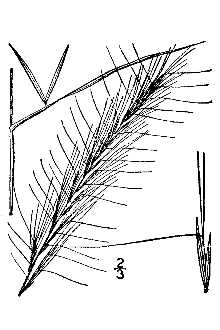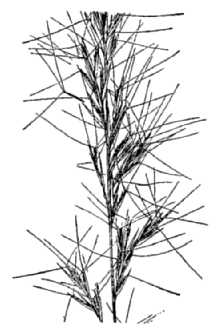Arrowfeather Threeawn
Scientific Name: Aristida purpurascens Poir.

| General Information | |
|---|---|
| Usda Symbol | ARPU8 |
| Group | Monocot |
| Life Cycle | Perennial |
| Growth Habits | Graminoid |
| Native Locations | ARPU8 |
Plant Guide
Use a soil moisture meter to monitor the soil moisture where Arrowfeather Threeawn is planted.
Fact Sheet
Alternate Name
arrowfeather
Uses
Cattle graze arrowfeather threeawn a few weeks in the early spring. It produces low-quality forage the rest of year.
Status
Please consult the PLANTS Web site and your State Department of Natural Resources for this plant’s current status, such as, state noxious status and wetland indicator values.
Description
Arrowfeather threeawn is a native, cool-season, weak, perennial bunch grass. The height is between 1-1/2 and 2 feet. The leaf blade is flat; narrow; 4 to 12 inches long; tends to lie down and curl into ringlets, especially as plant matures. The seedhead is a narrow panicle that is sometimes lax and nodding, and one-third to one-half the height of the plant. The awns are about 1/2 to 3/4 inch long, equal length, and drop off a few weeks after the seeds ripen. From Britton & Brown (1913) @ plants.usda.gov Distribution: For current distribution, please consult the Plant Profile page for this species on the PLANTS Web site.
Management
Because this grass increases on all sites, it can be managed to reduce it from the plant community by close grazing 2 to 3 weeks in the spring just before seedheads appear. Deferred grazing that allows warm season grasses to grow and mature later in the season will convert the range through natural plant succession to warm-season grasses. It withstands annual burning.
Establishment
Arrowfeather threeawn growth starts about 2 weeks before that of most warm-season grasses, It usually produces a good seed crop in June, then becomes dormant, It greens up in the fall if moisture is available, Barblike hairs on the base of the seed help to plant them, Seedstalks do not deteriorate readily unless they are burned or broken off, It grows best on sandy soils and tolerates moderate shade, Cultivars, Improved and Selected Materials (and area of origin) Please contact your local NRCS Field Office, Use soil moisture sensors to measure the soil moisture of Arrowfeather Threeawn.,

